If you are wondering how to cook rice noodles, look no further! There are a few different cooking methods for dry rice noodles. They can help you make Tom Kha Gai, Mai Fun, Pad Thai, stir-fries, and all sorts of exciting dishes. Here’s the best way to make them!
This post contains affiliate links.
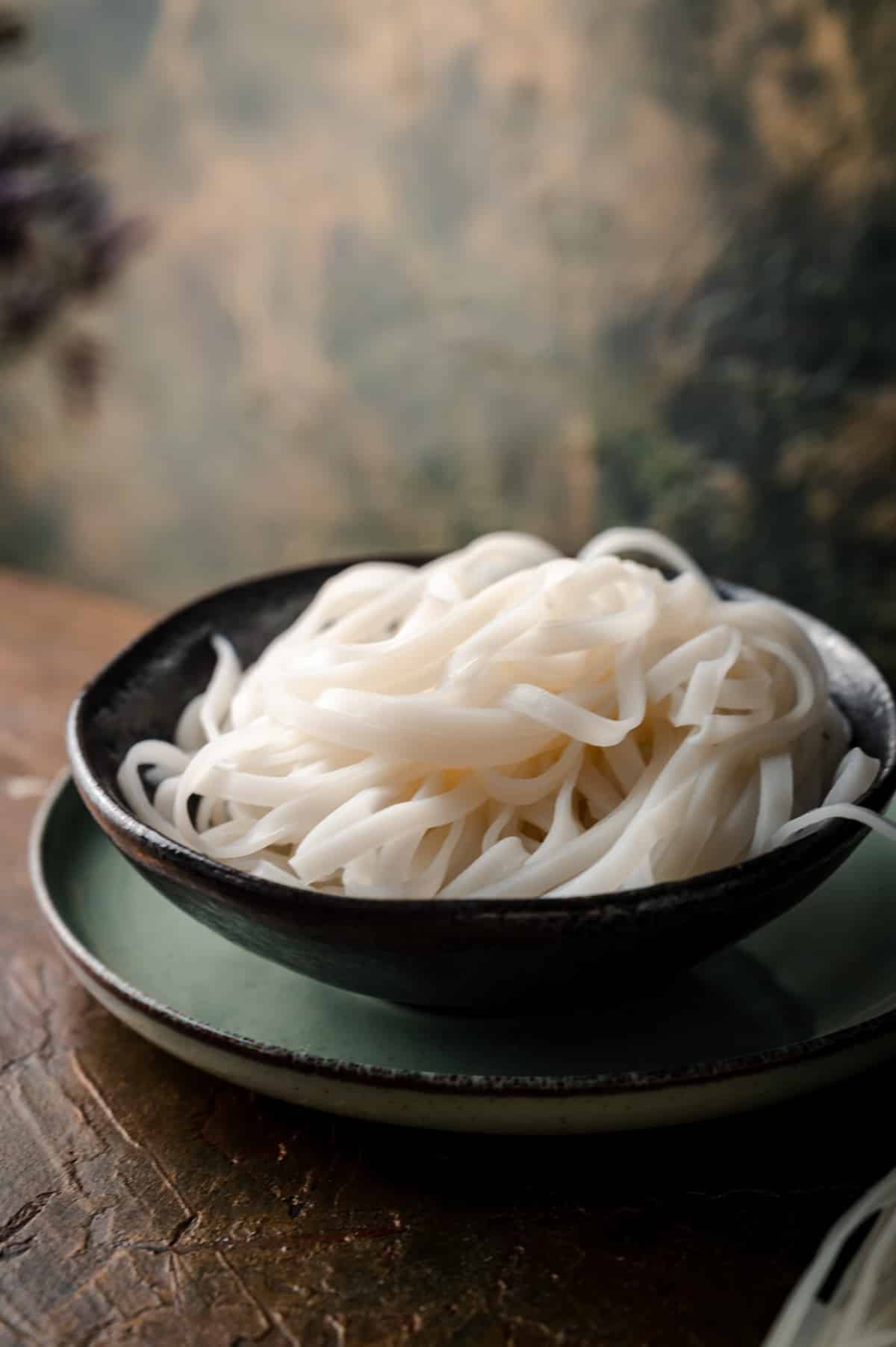
Why You’ll Love This Recipe
- Quick and easy: Rice noodles only take a few minutes to prepare. Once they’re ready, you can use them for a wide variety of dishes.
- Never boring: When you tire of other things, rice noodles give you more ways to experiment with Asian cuisine and fusion dishes in your kitchen.
- Healthy: Made with rice flour and water, rice noodles are a healthy option for making your meals more satisfying.
Types of Rice Noodles
Depending on where you live in the United States, you may find plenty of rice noodle options in your local supermarket. For a better selection, head to an Asian market where you’ll find a full spectrum of rice noodles, sometimes called ‘rice sticks.’ Asian markets are the place to shop if you are looking for fresh rice noodles! (Fresh noodles have a springy texture and are oh-so-good!)
Different Asian countries have different styles of noodles, though the main difference is that the widths vary. The common types of rice noodles that you’ll find are:
- Very thin: These are much like angel hair pasta. You may see these thin rice noodles labeled as rice vermicelli noodles.
- Thin: Thicker than the very thin variety, you can liken these to spaghetti for the rounded versions. You’d want this one for making Pad Thai noodles.
- Medium: Medium rice noodles are most like linguine. These are great with Chinese broccoli!
- Wide: If you make a dish like pad see ew, you’ll want these wide flat rice noodles.
In addition, there are also wild rice noodles, brown rice noodles, whole wheat noodles,
Most rice noodles are naturally gluten-free though you may see some brown rice noodle options too. They can be interchanged for regular rice noodles in any recipe, making them a versatile and healthy option.
Ingredients + Notes
This simple how-to noodle recipe has two simple main ingredients.
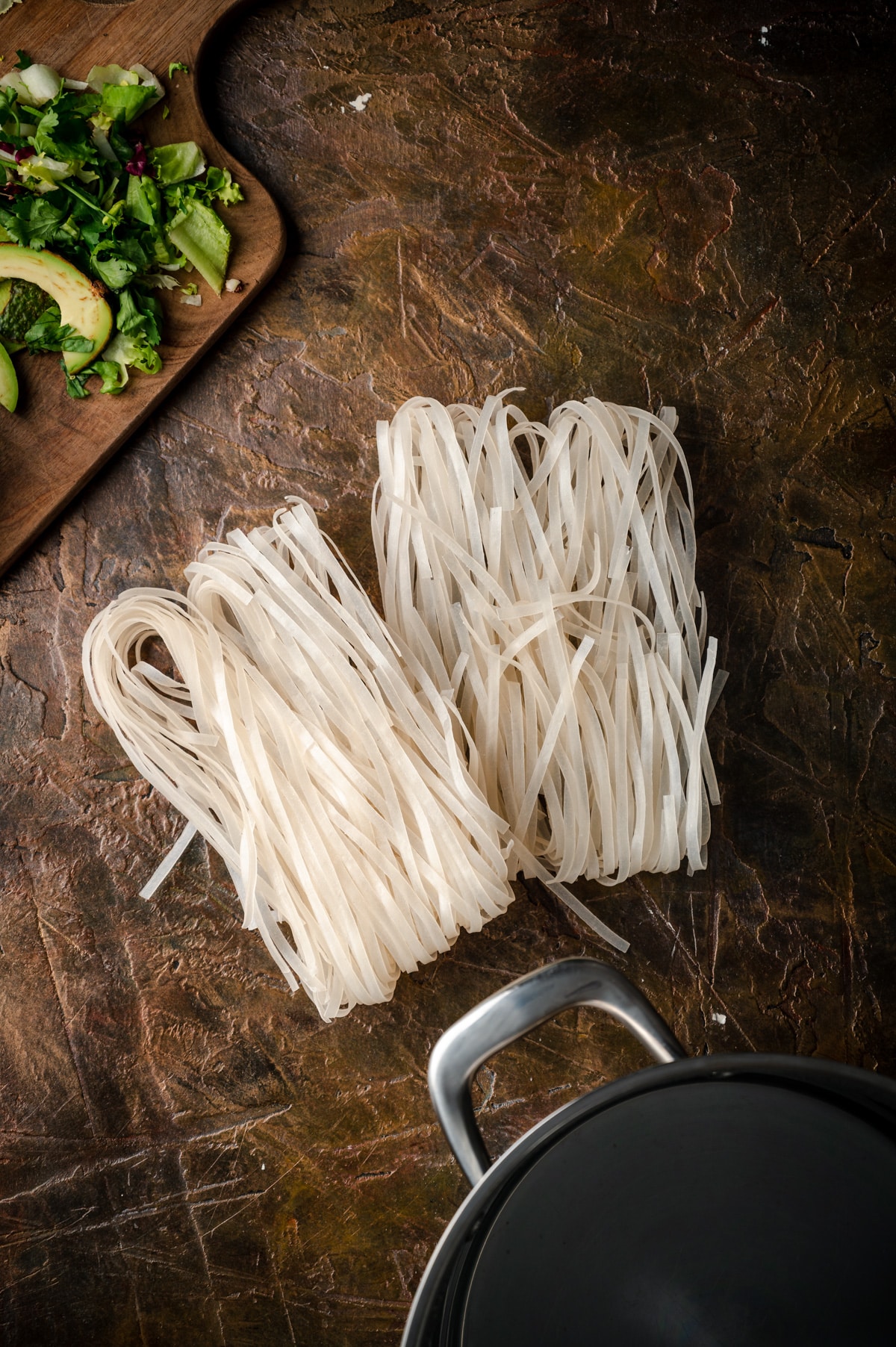
- Stir Fry Rice Noodles: As mentioned, there are several different rice noodle styles to choose from. The thinner the noodles, the more delicate they are, so when you need them to stand up in a recipe, go for something thicker.
- Water: You’ll be boiling the noodles to get them to the right consistency. Filtered water is best if you have the option.
Step-by-step Instructions: How To Cook Rice Noodles
When you want to make rice noodles, you’ll need to prep them ahead of your recipe. This only takes a few minutes to do and ensures they’ll have the perfect texture.
1. Boil: Bring a medium pot of water to a boil over high heat. (This should take about 7 minutes, depending on if you are cooking on a gas stove or electric.) (An 4 to 6-quart pot allows plenty of room for the noodles to separate.
2. Turn off the stove and add rice noodles to the pot.
3. Gently stir the rice noodles to ensure they are fully submerged and begin to separate.
4. Cover with a lid and let the rice noodles sit in the hot water for 5-10 minutes. (Until the noodles are al dente.)
This soaking time will vary depending on the thickness and width of the rice noodle you picked. Start checking the rice noodles every 30-60 seconds at the 5-minute mark to ensure you don’t overcook them. (This would result in overly soft, mushy, and potentially sticky noodles.)
5. Strain the noodles and briefly rinse with cool water.
Full Recipe Video
Ways To Use Rice Noodles
Rice noodles are incredibly versatile. Here are some ideas on how to serve them.
Use In Noodle Soup
When using rice noodles in soup, cook as directed above. Then, add a serving of rice noodles to each bowl of soup. This will ensure that they don’t overcook.
Try this out in this Rice Noodle Coconut Curry Soup!
Use In A Stir-Fry
Enjoy rice noodle stir-fries by following the above directions when using rice noodles in a stir-fry. Then, add the rice noodles to the stir-fry for the last 1-3 minutes. This will ensure that they soak up the sauce but don’t get overcooked. This Thai Vegetable Stir Fry is the perfect addition to these easy rice noodles.
Use In Cold Rice Noodle Salads
In addition to following this recipe, you may wish to cook the rice noodles for an additional minute, so they are slightly closer to being fully “done.” You may want to do this because when adding rice noodles to a cold salad, they won’t be cooking any longer in the finished product. In addition, you will want to thoroughly rinse the noodles in cold water, so they don’t warm up your salad.
Use In Spring Rolls
Follow the above recipe, except you may wish to cook the rice noodles for an additional minute, so they are slightly closer to being fully “done.” You may want to do this because when adding rice noodles to a spring roll, they may no longer be cooking in the finished product. In addition, you will want to thoroughly rinse the noodles in cold water so they don’t warm up your spring rolls if your plan is to eat them cold.
Pair With Cooked Veggies
Add this 10-minute Bok Choy recipe with freshly made rice noodles for a burst of flavor.
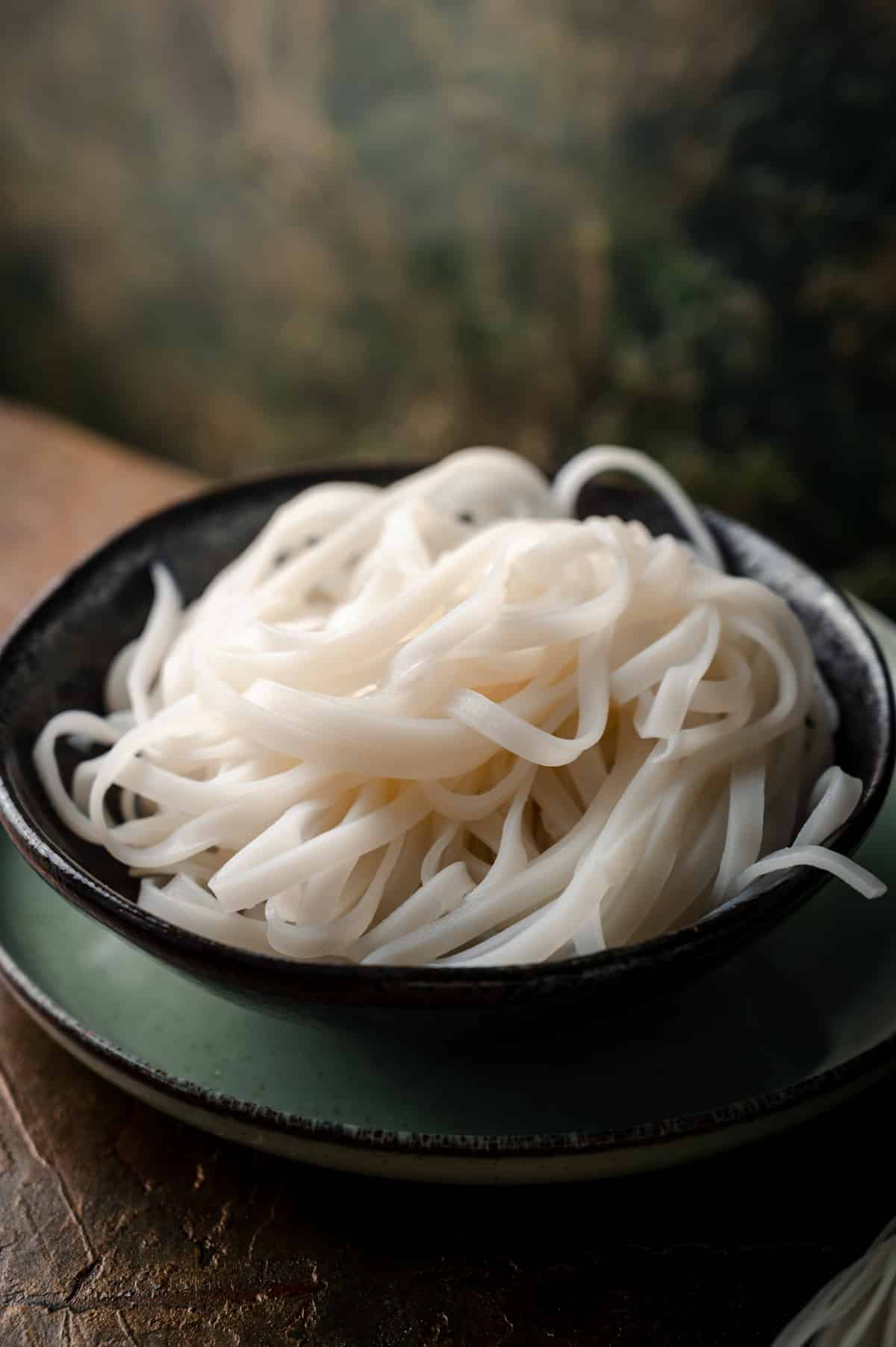
Additional Cooking Methods
If you don’t want to dirty a pot or if you don’t have a cooktop, you can still enjoy your favorite rice noodles.
1. Boil water in an electric tea kettle or a tea kettle on the stovetop.
2. Put a serving of rice noodles in a large mixing bowl. (I recommend a ceramic or glass bowl that can take the heat. Do not use plastic.) (One serving is typically about 2oz of dried noodles.)
3. Once the water boils, immediately pour the boiling water over the noodles in the bowl.
4. Ensure that the noodles are fully submerged and separated.
5. Cover with a lid (or dinner plate) and let the rice noodles sit in the hot water for 5-10 minutes. (Until the noodles are al dente.)
This soaking time will vary depending on the thickness and width of the rice noodle you picked. Start checking the rice noodles every 30-60 seconds at the 5-minute mark to ensure you don’t overcook them. (This would result in overly soft, mushy, and potentially sticky noodles.)
6. Strain the noodles and briefly rinse them with cold water.
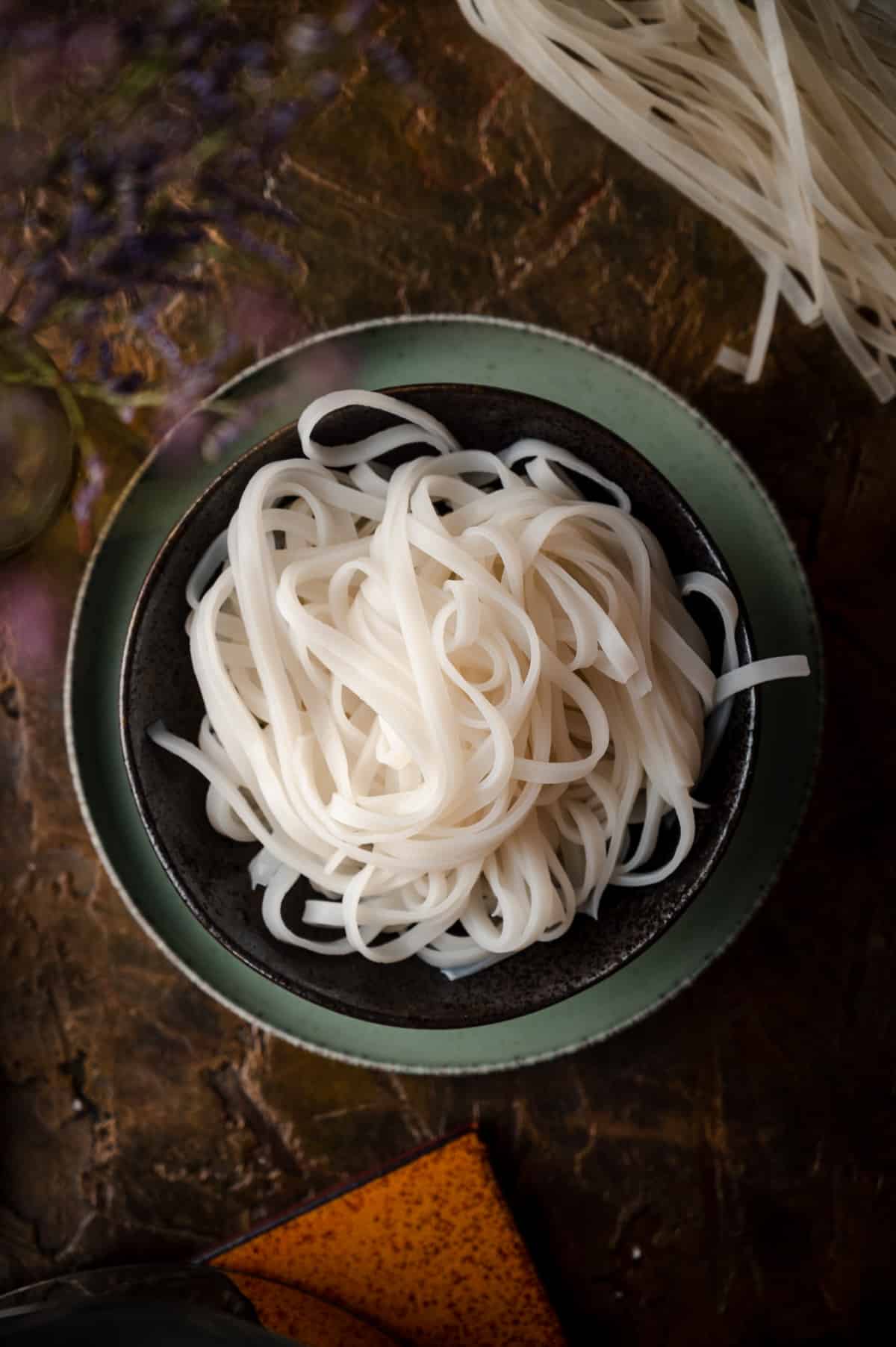
What goes well with rice noodles?
Rice noodles are so versatile that you can put them with just about anything. Even with a little soy sauce and lime, it’s a delicious experience. Many people make stir-fried dishes with fresh veggies like onion, bell peppers, mushrooms, and bok choy. Singapore rice noodles, noodle bowls, pad Thai, pad see ew, drunken noodles, Vietnamese noodle salad, and spring rolls. And there’s plenty more you can make with them too!
Here are some popular ingredients that are often paired with hydrated rice noodles.
- Onion
- Green Onion
- Bok Choy
- Bell Peppers
- Chinese Broccoli
- Mushrooms
- Soy Sauce
- Vegan Fish Sauce
- Vegan Oyster Sauce
- Bean Sprouts
- Sesame Oil
- Peanut Lime Dressing
- Sweet Soy Sauce
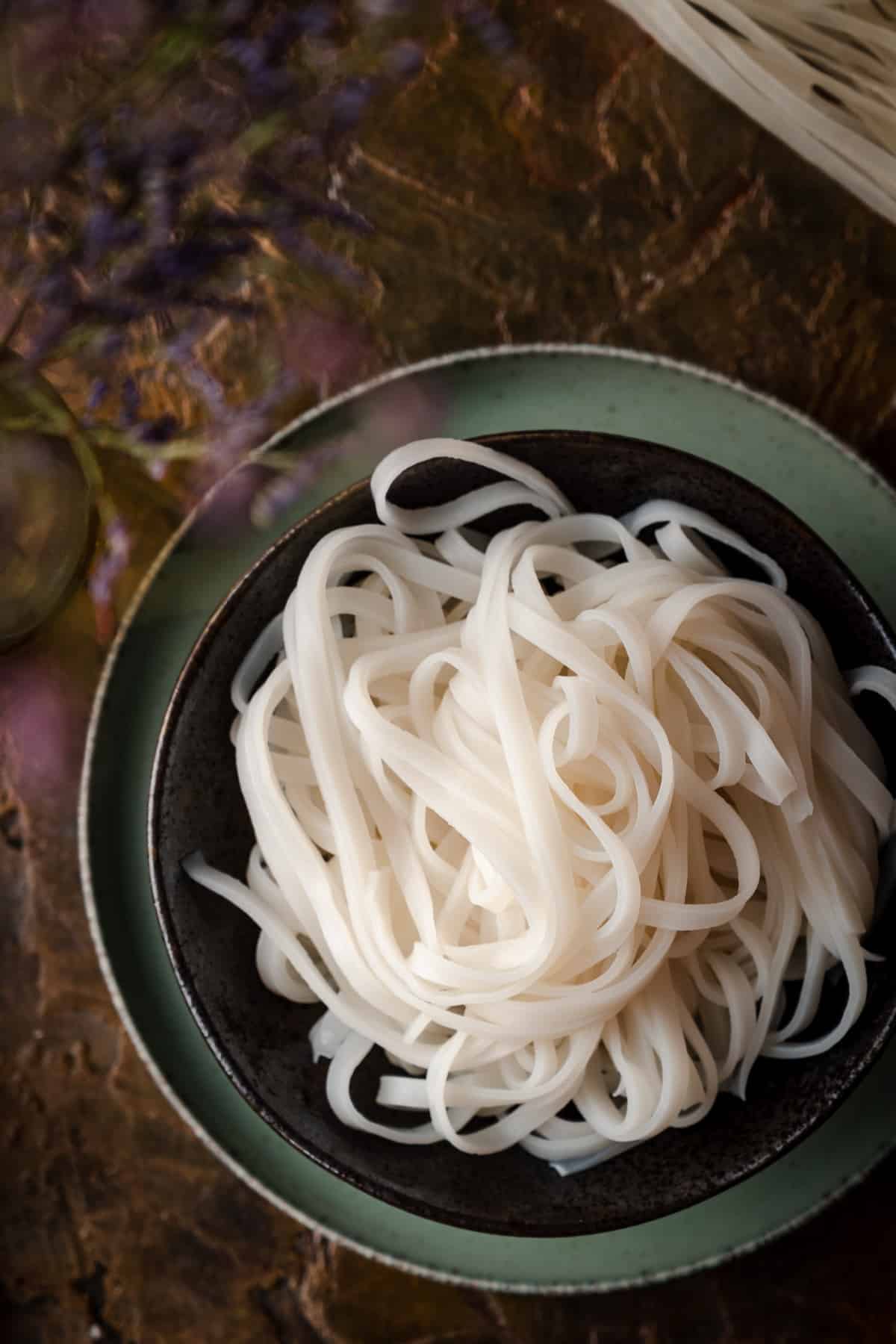
Storage Tips
Just like with other types of pasta, you may make more rice noodles than you intended to make. Fortunately, they keep rather well. Put them in an airtight container or zipper bag, and they’ll be good for up to 4 days in the fridge. You can also freeze them, which is fantastic for meal prep or busy nights. In there, you’ll want to use them within 2 months.
FAQ
It takes about 5 to 10 minutes to cook rice noodles. You may also want to factor in the time it takes for the water to boil if you’re in a time crunch, which is approximately 7 minutes.
People seem to be pretty torn on this issue. However, boiling them like you would any other kind of pasta will get you tender results that work in any dish that calls for rice noodles.
There are three steps to making sure your rice noodles don’t stick.
1. Be sure not to overcook your rice noodles.
2. When you are done cooking your rice noodles, be sure to rinse them thoroughly in cold water.
3. Toss the noodles in a sauce of your choosing immediately.
Recipe
How To Cook Rice Noodles
Ingredients
- 1 Packet Stir Fry Rice Noodles
- Water
Instructions
- Boil: Bring a medium pot of water to a boil over high heat. (This should take about 7-minutes, depending on if you are cooking on a gas stove or electric.) (An 8-quart pan allows plenty of room for the noodles to separate.
- Turn off the stove and add rice noodles to the pot.
- Gently stir the rice noodles to ensure they are fully submerged and begin to separate.
- Cover with a lid and let the rice noodles sit in the hot water for 5-10 minutes. (Until the noodles are al dente.) This soaking time will vary depending on the thickness and width of the rice noodle you picked. Start checking the rice noodles every 30-60 seconds at the 5-minute mark to make sure you don’t overcook them. (This would result in overly soft, mushy, and potentially sticky noodles.)
- Strain the noodles and briefly rinse with cool water.
Video
Notes
Nutrition
This post may contain affiliate links, meaning I’ll receive a commission if you purchase through those links at no extra cost to you. Please read our full disclosure for more information. Thank you for supporting Raepublic.

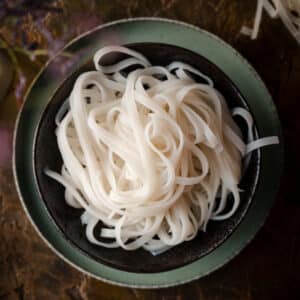
These instructions are simple to follow yet wonderfully detailed. Thank you!
Excellent! So glad you found it helpful.